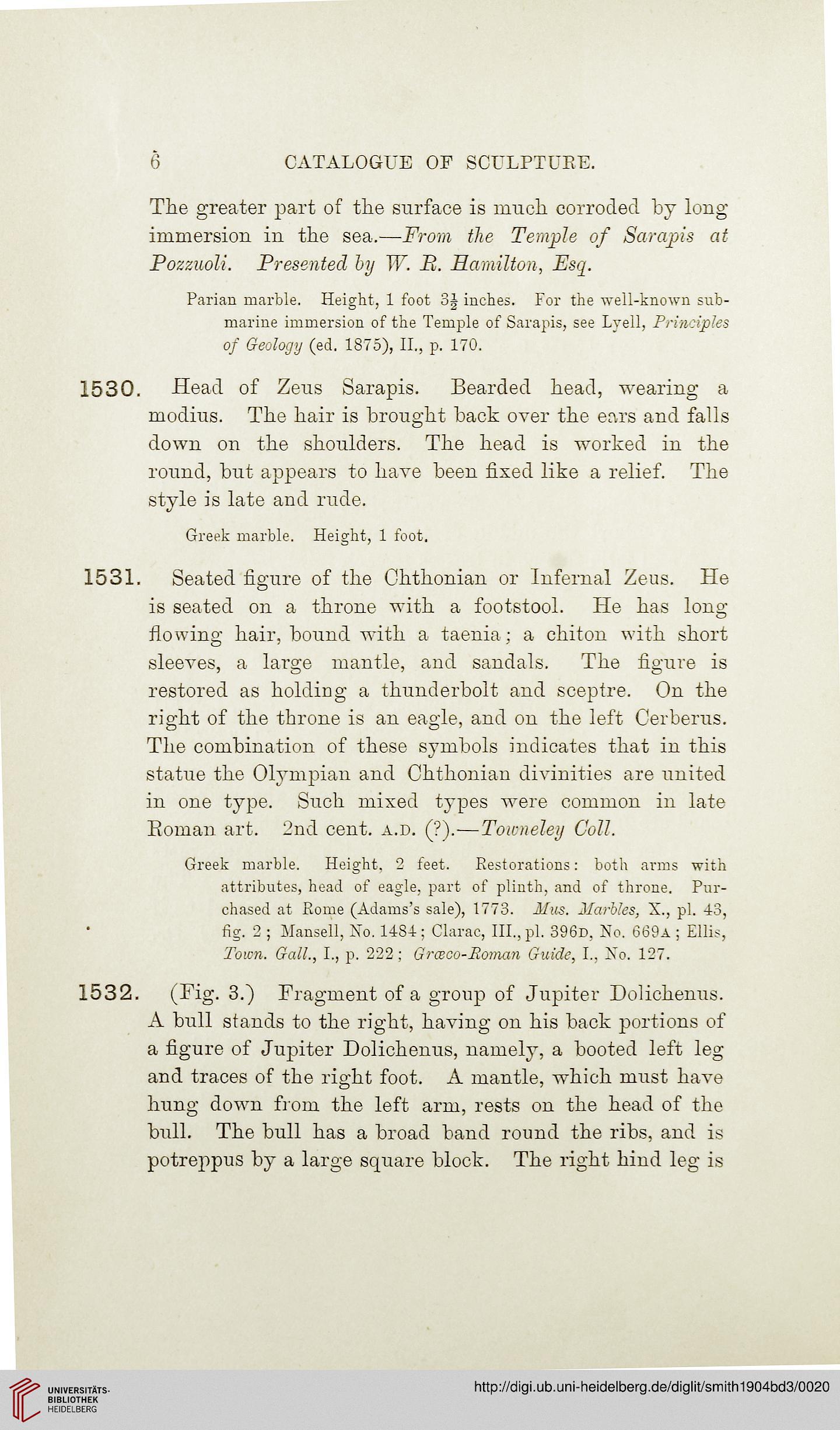6
CATALOGUE OF SCULPTUEE.
The greater part of the surface is much corroded by long
immersion in the sea.—From the Temple of Sarapis at
Pozzuoli. Presented by W. It. Hamilton, Esq.
Parian marble. Height, 1 foot 3| inches. For the well-known sub-
marine immersion of the Temple of Sarapis, see Lyell, Principles
of Geology (ed. 1875), II., p. 170.
1530. Head of Zeus Sarapis. Bearded head, wearing a
modius. The hair is brought back over the ears and falls
down on the shoulders. The head is worked in the
round, but appears to have been fixed like a relief. The
style is late and rude.
Greek marble. Height, 1 foot.
1531. Seated figure of the Chthonian or Infernal Zeus. He
is seated on a throne with a footstool. He has long
flowing hair, bound with a taenia ; a chiton with short
sleeves, a large mantle, and sandals. The figure is
restored as holding a thunderbolt and sceptre. On the
right of the throne is an eagle, and on the left Cerberus.
The combination of these symbols indicates that in this
statue the Olympian and Chthonian divinities are united
in one type. Such mixed types were common in late
Eoman art. 2nd cent. a.d. (?).—Toicneley Coll.
Greek marble. Height. 2 feet. Restorations: both arms with
attributes, head of eagle, part of plinth, and of throne. Pur-
chased at Rome (Adams's sale), 1773. Mus. Marbles, X., pi. 43,
fig. 2 ; Mansell, No. 1434; Chirac, III., pi. 396d, No. 669a ; Ellis,
Town. Gall., I., p. 222; Grwco-Hornan Guide, I., No. 127.
1532. (Fig. 3.) Fragment of a group of Jupiter Dolichenus.
A bull stands to the right, having on his back portions of
a figure of Jupiter Dolichenus, namely, a booted left leg
and traces of the right foot. A mantle, which must have
hung down from the left arm, rests on the head of the
bull. The bull has a broad band round the ribs, and is
potreppus by a large square block. The right hind leg is
CATALOGUE OF SCULPTUEE.
The greater part of the surface is much corroded by long
immersion in the sea.—From the Temple of Sarapis at
Pozzuoli. Presented by W. It. Hamilton, Esq.
Parian marble. Height, 1 foot 3| inches. For the well-known sub-
marine immersion of the Temple of Sarapis, see Lyell, Principles
of Geology (ed. 1875), II., p. 170.
1530. Head of Zeus Sarapis. Bearded head, wearing a
modius. The hair is brought back over the ears and falls
down on the shoulders. The head is worked in the
round, but appears to have been fixed like a relief. The
style is late and rude.
Greek marble. Height, 1 foot.
1531. Seated figure of the Chthonian or Infernal Zeus. He
is seated on a throne with a footstool. He has long
flowing hair, bound with a taenia ; a chiton with short
sleeves, a large mantle, and sandals. The figure is
restored as holding a thunderbolt and sceptre. On the
right of the throne is an eagle, and on the left Cerberus.
The combination of these symbols indicates that in this
statue the Olympian and Chthonian divinities are united
in one type. Such mixed types were common in late
Eoman art. 2nd cent. a.d. (?).—Toicneley Coll.
Greek marble. Height. 2 feet. Restorations: both arms with
attributes, head of eagle, part of plinth, and of throne. Pur-
chased at Rome (Adams's sale), 1773. Mus. Marbles, X., pi. 43,
fig. 2 ; Mansell, No. 1434; Chirac, III., pi. 396d, No. 669a ; Ellis,
Town. Gall., I., p. 222; Grwco-Hornan Guide, I., No. 127.
1532. (Fig. 3.) Fragment of a group of Jupiter Dolichenus.
A bull stands to the right, having on his back portions of
a figure of Jupiter Dolichenus, namely, a booted left leg
and traces of the right foot. A mantle, which must have
hung down from the left arm, rests on the head of the
bull. The bull has a broad band round the ribs, and is
potreppus by a large square block. The right hind leg is




